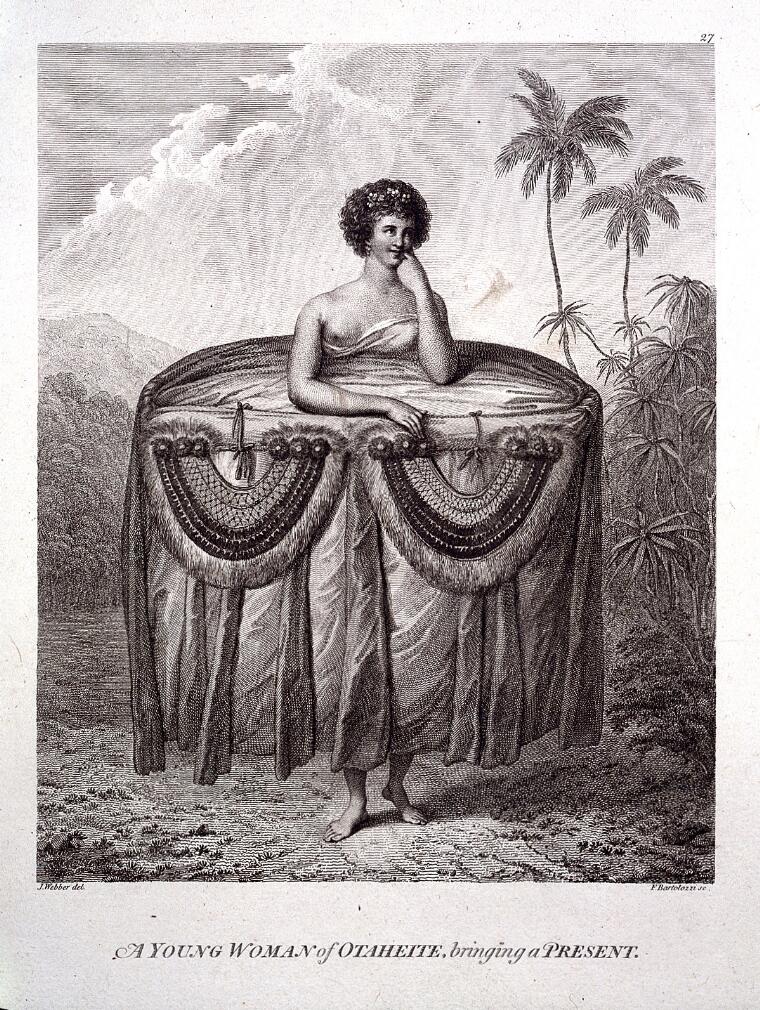Week 12. The Male Gaze: Sexuality, Exoticism and Disease in Pacific Voyaging
The earliest European expeditions to Polynesia, in the late 1760s and 1770s, carried back tales of an erotic island paradise where local men and women engaged in sex freely and newcomers were encouraged to join in. The sexual customs observed in Tahiti became a hot topic of Enlightenment debates, focused on a notion of "natural" or primitive sexuality that served as a foil to criticise the supposedly "unnatural" constraints imposed by European civilisation. Yet the romanticised image of free love carried dark and destructive consequences, as the venereal diseases transmitted by successive waves of European travellers resulted in widespread infertility, mortality, and indigenous depopulation all along the shores and archipelagos of the wider Pacific world.
Core Readings (pick two)
Roy Porter, 'The Exotic as Erotic: Captain Cook at Hahiti', in: G.S. Rousseau and Roy Porter (eds.), Exoticism in the Enlightenment (Manchester: Manchester University Press, 1989), pp. 117-144. Link.Link opens in a new window
Carol E. Harrison, 'Replotting the Ethnographic Romance: Revolutionary Frenchmen in the Pacific, 1768–1804', Journal of the History of Sexuality 21.1 (2012), pp. 39-59. LinkLink opens in a new window.
David Igler, The Great Ocean: Pacific Worlds from Captain Cook to the Gold Rush (Oxford: Oxford University Press, 2013), Ch. 2: 'Disease, Sex, and Indigenous Depopulation', pp. 43-71. LinkLink opens in a new window.
Primary sources
Browse the relevant primary sources in the section on Australasia in Empire OnlineLink opens in a new window and/or search for expedition accounts for e.g. the Wallis, Bougainville, or Cook voyages on Eighteenth Century Collections OnlineLink opens in a new window. Choose one account, browse its contents, and sketch a plan for a primary source-based essay following the instructions on MoodleLink opens in a new window.
Seminar Questions
- How did European travel to the Pacific shape Enlightenment understandings of sexuality and civilization, and how did these ideas change over time?
- What are the different ways in which the sexual encounters between Pacific Islanders and Europeans have been understood? Which do you regard as most appropriate?
- What was the long-term impact of European understandings of the Pacific as an erotic paradise?
- What would a history of travel look like that puts disease at the heart of its narrative?
- Porter describes European descriptions of Tahiti as "Eurocentric and phallocentric" (138). How is the European male gaze manifest in the primary sources?
Further Reading
Calder, Alex, Jonathan Lamb and Bridget Orr (eds.), Voyages and Beaches: Pacific Encounters, 1769-1840 (Honolulu: University of Hawaii Press, 1999). LinkLink opens in a new window.
Festa, Lynn, 'Life, Liberty, and the Pursuit of Tahitian Jouissance', Romance Quarterly 54.4 (2007), pp. 303-325.
Lamb, Jonathan, Preserving the Self in the South Seas, 1680-1840 (Chicago: Chicago University Press, 2001). LibraryLink opens in a new window.
Lansdown, Richard (ed.), Strangers in the South Seas: The Idea of the Pacific in Western Thought (Honolulu: University of Hawaii Press, 2006). LinkLink opens in a new window. [primary source excerpts].
Martin, Andy, 'The Enlightenment in Paradise: Bougainville, Tahiti, and the Duty of Desire', Eighteenth-Century Studies 41.2 (2008), pp. 203-216. LinkLink opens in a new window.
Morgan, Jennifer L.,'"Some Could Suckle over Their Shoulder": Male Travelers, Female Bodies, and the Gendering of Racial Ideology, 1500-1770', William and Mary Quarterly 54.1 (1997), pp. 167-192. LinkLink opens in a new window.
Munro, Doug, and Brij V. Lal (eds.), Texts and Contexts: Reflections in Pacific Islands Historiography (Honolulu: University of Hawaii Press, 2005). LinkLink opens in a new window.
Nussbaum, Felicity, Torrid Zones: Maternity, Sexuality and Empire in Eighteenth-Century English Narratives (Baltimore and London: Johns Hopkins University Press, 1995). LibraryLink opens in a new window.
Porter, Dennis, Haunted Journeys: Desire and Transgression in European Travel Writing (Princeton, NJ: Princeton University Press, 1990), esp. Ch. 3: 'Circumnavigation: Bougainville and Cook', pp. 86–122. LinkLink opens in a new window.
Pritchard, Annette, and Nigel J. Morgan, 'Privileging the Male Gaze: Gendered Tourism Landscapes', Annals of Tourism Research 27.4 (2000), pp. 884-905. LinkLink opens in a new window.
Rod, Edmond, 'The Pacific/Tahiti: Queen of the South Sea Isles', in: Peter Hulme and Tim Youngs (eds.), Cambridge Companion to Travel Writing (Cambridge: Cambridge University Press, 2002), pp. 139-155. LinkLink opens in a new window.
Sheriff, Mary, 'Nails, Necklaces and Curiosities: Scenes of Exchange in Bougainville's Tahiti', Art History 38.4 (2015), pp. 792-805. LinkLink opens in a new window.
Tcherkézoff, Serge, First Contacts in Polynesia: The Samoan Case (1722-1848) Western Misunderstandings about Sexuality and Divinity (Canberra: ANU Press, 2008). LinkLink opens in a new window.
Tcherkézoff, Serge, 'A Reconsideration of the Role of Polynesian Women in Early Encounters with Europeans: Supplement to Marshall Sahlins′ Voyage around the Islands of History', in: Margaret Jolly, Serge Tcherkézof, and Darrell Tyron (eds.), Oceanic Encounters: Exchange, Desire, Violence (Canberra: ANU Press, 2009), pp. 113-160. LinkLink opens in a new window.
Thomas, Nicholas, Islanders: the Pacific in the Age of Empire (New Haven: Yale University Press, 2010). LibraryLink opens in a new window.
Tilburg, Marja van, 'The allure of Tahiti Gender in Late Eighteenth-Century French Texts on the Pacific', History Australia 3.1 (2006). pp. 13.1-13.16. LinkLink opens in a new window.
Wallace, Lee, Sexual Encounters: Pacific Texts, Modern Sexualities (Ithaca: Cornell University Press, 2003), Ch. 2: 'Sexual Encounter In Hawaii On Cook's Third Voyage', pp. 38-56. LinkLink opens in a new window.
West-Sooby, John (ed.), Discovery and Empire: the French in the South Seas (Adelaide: University of Adelaide Press, 2013). LinkLink opens in a new window.
Williams, Glyndwr, 'Tupaia: Polynesian Warrior, Navigator, High Priest, and Artist', in: Felicity A. Nussbaum (ed.), The Global Eighteenth Century (Baltimore: Johns Hopkins University Press, 2003), pp. 38-51. Library.Link opens in a new window
Wilson, Kathleen, The Island Race: Englishness, Empire and Gender in the Eighteenth Century (London and New York: Routledge, 2003). LinkLink opens in a new window.

Empire Online - extensive database of written and visual primary sources.
The Pacific - Oxford Bibliographies. By Kate Fullagar (2013).
